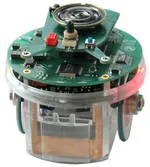The ePuck robot is a small coffemug-sized tabletop robot. It is equipped with various sensors (proximity sensors, ground sensors, camera, microphone, IR communication, ...) and a powerful embedded ARM processor system. In the course of an experiment a very big amount of data can be sampled and has to be collected from the sensors. Most of the times the amount of data is too much to be stored on the robot itself and must therefore be transferred to a remote workstation to be processed further.
This requires fast sampling and processing of sensory input data in high dimensions and a low-latency transfer via a wireless connection to a base station (laptop computer).
Humans also process a very big amount of sensory data at each point in time, but contrary to reactive robots, they form predictions about their environment and the sensory input. This means, they are predicting how the sensory inputs will change in a small time ahead in the future. This behavior is called nexting.
In this Forschungspraxis nexting is to be implemented on the base station together with the low-latency sampling and data transfer.
As a result, nexting is performed off-board and the sensor predictions are transferred back to the robot for an optimized control strategy.
The working packages of this project include:
Research of relevant literature.
Integration of an existing wireless framework for data transfer. (Python/C/C++)
Adapting nexting on the base station. (Python)
Clear experiment description and documentation.
Evaluation of computational performance as well as empirical verification of algorithm correctness.
Project Start: September
This project can be done in german or english.
High Performance Low Latency Nexting on a Tabletop Robot
Forschungspraxis, Johannes Feldmaier, Aktuelles |
